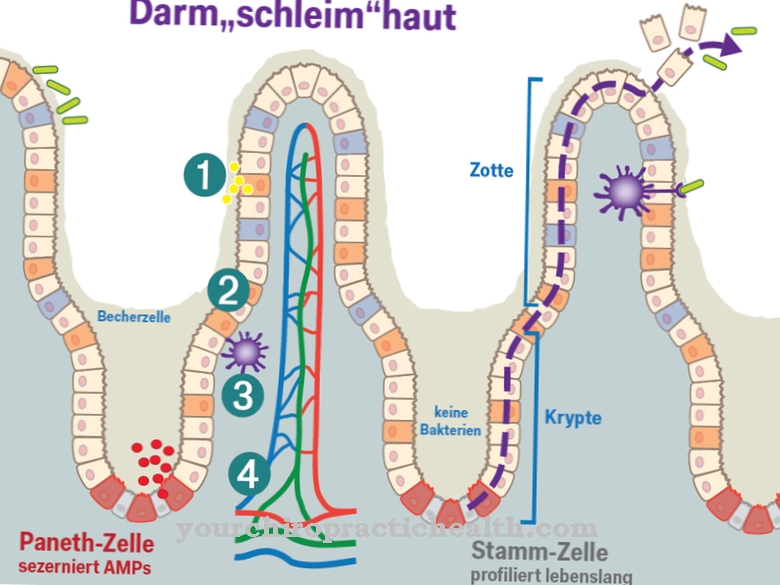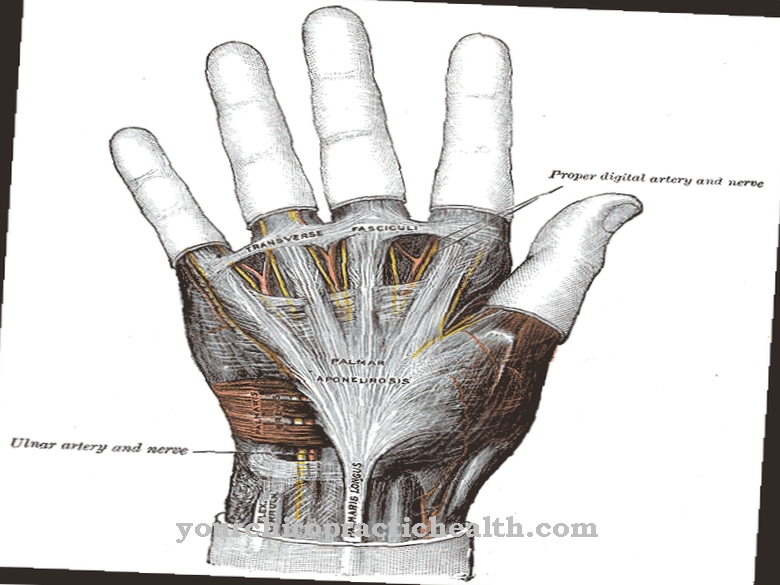The functionality of the joint movements is not as simple as it usually seems in everyday life. With regard to the knee joint, nature resorted to a trick to facilitate muscle movements in the thigh. So she set up an additional, slidingly moving bone: the Kneecap.
What is the kneecap?
The Kneecap is a bone that is disc-shaped and rounded triangular in shape and lies in front of the knee joint. In technical language it is also called patella designated.
When the knee is flexed, the muscles of the front thigh have to exert force on the lower leg. To do this, the knee joint needs a kind of spacer, the function of which is taken over by the kneecap and thus acts as a force redirection.
Since the kneecap is embedded in a sliding channel and is therefore mobile, it also sits loosely over the knee joint, i.e. H. you can easily move them from the outside. Because of this, the kneecap is very sensitive and therefore particularly prone to injuries and fractures.
Anatomy & structure
The approach of the Kneecap is located at the top of the thigh muscles and at the bottom of their tendon on the shin.
Since a tendon always has to be connected to a muscle, according to the technical definition, the kneecap tendon is not a tendon, but rather a ligament that connects the kneecap with the shinbone.
In order to be able to guarantee a movement of the knee push when the force of the thigh muscles is transmitted, it is embedded in a slide channel in which it can slide back and forth when the leg is bent and stretched. There is a layer of cartilage on its back surface.
Function & task
So that the force of the thigh muscles can act on the shin, a movable spacer is required to make it possible to bend and stretch the leg at all.
The kneecap takes on this function and can slide approx. 10 cm in its slide channel. It serves as a lever arm to reduce the effort. It is thus a physical force diverter and increases the distance between the force vector of the anterior thigh muscle and the rotation center of the knee joint.
Because the kneecap is embedded in a tendon and acts as an extended lever arm, it is often referred to as the sesamoid bone. Furthermore, the kneecap protects the tendon that originates in the thigh muscles from damage caused by excessive pressure. So that the kneecap can slide at all, there are two bursa on the knee joint to reduce the pressure and friction between the tendons, muscles, bones and skin.
Illnesses & ailments
A common complaint of the Kneecap is the kneecap dislocation in which she jumped out of her slideway. The capsular ligaments can be torn. Once the kneecap has jumped out of its slideway, there is a risk that it could happen again and again.
A common disease of the kneecap is kneecap arthrosis. The causes of this disease are mostly genetic, for example a misalignment of the kneecap, poor quality of the cartilage or general leg malpositions (knock knees, bow legs).
If the kneecap runs too far outside in the gliding channel, one speaks of a patallal lateralization, which leads to an asymmetrical load on the kneecap. Causes can be incorrect positioning of the gliding channel or the kneecap itself or muscle weakness.
In children and adolescents, their kneecap can be overstrained due to their growth, which decreases again in adulthood and can lead to discomfort, especially when climbing stairs.
In addition, one of the bursa on the knee joint can become inflamed due to a skin injury, which can lead to a knee infection or even blood poisoning. In this case, the affected bursa must be removed. Athletes often suffer from an overload of the tendon in which the kneecap is inserted, which can lead to a degenerative disease of the kneecap.
If external force is used on the kneecap, it can lead to a fracture. B. can cause the consequential damage that the kneecap more easily jumps out of the slideway, which could happen again and again as a result.













.jpg)

.jpg)
.jpg)











.jpg)